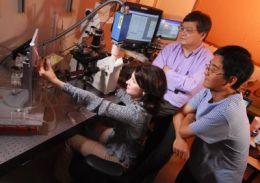|
Researchers show evidence of 'memory' in cells and molecules

Veronika Zarnitsyna, Cheng Zhu and Jun Huang
(l-r) use a biomembrane force probe for experiments on
single-molecule mechanics. Credit: Gary Meek
Research to be reported October 29 in the journal
Proceedings of the National Academy of Sciences provides
evidence that some molecular interactions on cell surfaces may
have a memory that affects their future interactions. The report
could lead to a re-examination of results from certain
single-molecule research.
"If you are probing a cell to get a bit of information, how do
you know that the cell is not going to respond by changing the
information it reveals the next time you probe it? asked Cheng
Zhu,
a Regents™ Professor in the Coulter Department of Biomedical
Engineering at Georgia Tech and Emory University. If you are
probing a molecule, can you assume that the molecule will return
to its original configuration before you test it the next time?
We didn't think about this until we had been doing these kinds
of experiments for more than ten years.
Supported by the National Institutes of Health, the research
demonstrates that certain cells can remember their earlier
encounters through specific receptor-ligand interactions. That
would
mean that some sequential measurements may not have been truly
independent, and could therefore prompt re-examination of some
research that obtained data under the i.i.. assumption.
People doing research in this area ought to look at what we have
found to see if their systems also have memories that may have
affected their conclusions, Zhu said. They may discover new
aspects that may have been overlooked.
Using a micropipette adhesion frequency assay, Zhu's research
team studied a number of receptor-ligand interactions. The
sequence data analysis conducted by Veronika Zarnitsyna, a
research scientist in the Coulter Department, revealed examples
in which an interaction observed in one test affected the
outcome of a future test. Depending on the biological system,
the effect could either increase or decrease the likelihood of a
future interaction.
For instance, interaction between T cell receptors and an
antigen bound to major histocompatibility molecules showed
positive correlation, with one interaction increasing the
likelihood of a future interaction. Interaction between
C-adherins exhibited the opposite behavior, with one interaction
reducing the likelihood of a future interaction. In a third
system the researchers studied, the events appeared to be truly
independent, with one interaction not affecting a future one.
The i.i.. assumption in single-molecule experiments was
something that people usually took for granted, Zarnitsyna said.
The research reported in PNAS began when Jun Huang, a graduate
student in the Zhu lab, examined T cell test data and noted a
distinct difference: interactions appeared consecutively in long
strings and then disappeared for a long while. Huang asked Zhu
about the pattern. Zhu then shared his concerns about the
independence of the tests with Zarnitsyna, a biophysicist.
Zarnitsyna analyzed data generated by Huang and Fang Zhang "
another graduate student in the Zhu lab " and additional data
obtained in the lab by Yuan-Hung Chien, a student from the
laboratory of Deborah Leckband at the University of Illinois at
Urbana-Champaign.
Positive memory increases the likelihood of having two
interactions in a row, which generates long strings of
interactions, said Zarnitsyna. The negative memory, conversely,
decreases the likelihood of having consecutive interactions,
which results in more solitary interactions in the sequence.
Zhu compares the negative correlation to the effects of strong
light on the eyes. If you go from the dark to the bright, time
is required before you can see well again, he noted. Exposure to
strong light temporarily inhibits the eyes' response to the next
input.
Zhu's research team studies single-molecule mechanics using
sensitive force techniques, such as atomic force microscopes and
biomembrane force probes, to put cells and molecules together
and then measure the forces or times required to pull them
apart. Ideas developed for
the adhesion frequency assay may also be applicable to this
research because the i.i.d. assumption is violated if the force
or time depends on where in a test sequence it was measured.
As a next step, Zhu would like to further characterize the
memory effect to determine how long it lasts. It seems
reasonable that if you prolong the cycle time. The period
between trials. the cell or
molecule would gradually forget, he said.
He would also like to study the biological mechanisms of the
memory effects.
We believe this phenomenon may be biologically important, though
we don't yet know the implications for it, Zhu said. This may
represent a way for cells to regulate their adhesion and
signaling. For T cells, the ability to remember' even a brief
interaction with a pathogen may be related to their ability to
tell an intruder from self molecules, which is crucial to the
body's defense in the immune system.
Source: Georgia
Institute of Technology
1 2 3 4 5 6 7 8 9 10 Newest
articles
|
